Attention: Music Students
Discover How to Create and Use Music Chords Effortlessly!
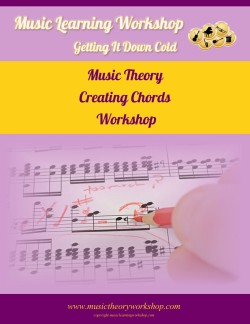 Who Else Wants to Spend Only 5 Minutes a Day to Master Music Chords!!!
Who Else Wants to Spend Only 5 Minutes a Day to Master Music Chords!!!
You Can with the Creating Chords Workshop.
Start Playing The Great Works Of Music Sooner Than You Thought Possible!
Hello Music Students and Teachers,
My name is Brad Chidester and I’m the owner of Music Learning Workshop.com.
I’ve studied music both the hard way and the easy way.
After finding out that there is a better, faster, and easier way to learn music I started this site as a way to help others learn music quicker and with less effort.
The Issue:
Music Chords are Taught Too Slowly And It Simply Takes Too Long
You can find a lot of information about music theory concepts that are the basis for music learning. However…
I even know that most teachers take way to long to get the theory taught to their students.
I know others that make sure you are getting it done at a much faster rate. And quite frankly you need to find one of those teachers.
Even if you’ve picked up the books that insult your intelligence, (you’re not dumb or an idiot), you are simply not informed. Please, you wouldn’t be looking for a resource like this if you were. Your smart because you’re looking for that great resource that’s going to get you where you want to go.
The Fast and Easy Way
That’s why I have developed workshops that accelerate your knowledge of these fundamental elements of music and allow you to learn music fast and get the concepts down cold.
Announcing A Fast And Easy Method To Learn And Master Chords, Chord Voicings, And Harmonic Systems
Without Brain Damage Or A College Education.
Click Here To Get Started With Chords Workshop Now
The Getting it Down Cold Creating Chords Story
Let me share a story with you that will tell how and why these workshops were created.
Ted’s plight
I was talking with a friend of mine, we’ll call him Ted, about learning music and here’s how it went:
You know Brad I just can’t seem to get a handle on chords. Sure I know a few of the basic ones like C and F and G. But when I have to think about E flat or A flat I just freeze up and can’t seem to get it. Then I, well…
Ted, let me interpret you for a second. You know, I was just like that for me when I first started studying music. I knew a few chords, but then there would be a minor chord and I would learn that and then I’d look at a new song and there would be this diminished chord and I didn’t even know what that was. I knew enough notes to play it, but it just plain didn’t make any since to me.
Boy, Do I ever know what you mean I’ve felt that way for quite a while, it gets frustrating.
Finding A Better Way
Ted, I got to tell you, I know where you’ve been and I was fortunate enough to find a teacher that completely changed the way I look at and study music.
I started getting deep into the theory of music and I learned all about major, minor, diminished, and augmented chords and the relationships between them.
Augmented chords, what’s that?
It’s a variation of the major chord and raises the fifth of the chord a half step. Fifth and half steps, I get that, but I’m still a little fuzzy on those ideas of when to or how to use them.
What You Need To Do
Let me see if I can help you. You need to sit down and learn about the chord structure and how that is developed with intervals and half steps or whole steps and then how the 4 basic three note chords are related.
Once you have that, you can then go and learn how all 84 chords are spelled.
84 chords?
Yup,
84 chords that’s really 4 variations of 1 chord 21 times. You see it’s just 21 chords with four slight changes and spellings. Actually there’s less than that, but many have two different spellings because of the key signature used. You know, sharps and flats that use the same notes but are named differently.
That’s just seems plain difficult. Key Signatures and spellings.
How It Worked
I thought so also, but you know what, in about 2 hours I had learned how to develop chords, created all the chord spellings and had set up a system to put them into deep memory by practicing part of them a few minutes every day. Actually I spent less than 5 minutes a day on it and have them all locked down in less than two months.
Not only that, I was able to learn about chord inversions and incorporated them into that plan of attack. I spent just an extra 2 minutes with each chord to learn those.
Say, I know about inversions, that’s where you move a note to a different location. It
sure is. But, you need to know intervals and relationships to truly understand how you can internalize these things in a matter of minutes and be able to produce the wanted inversion on the fly.
Using the Three Senses
Actually what you have to do is use all your sense of sound, feel, and sight together to get them into long term memory. The patterns are what made it happen for me. I’m a real visual person and adding that with playing (feel and sound) and seeing I just took off and learned them in no time at all.
What do you mean by patterns and pictures?
Our minds work with all our senses and when you focus on just using one you actually limit your ability to learn. You see our minds actually want to see a bigger picture and get more input, then focus in on the details and expand that back out again.
Patterns
So when you apply patterns and pictures of what you want to learn with the sound and the feel you can actually pre-load your subconscious with knowledge you need to learn quicker and faster.
This works in several ways.
You produce patterns or visual pictures that of letters or dots or black and white keys. Then you say them like in spelling a chord as in C – E – G is a C chord.
Add playing those notes on your instrument several times puts it all together and before you know it you’ve learned and own the chord and creating chords and variations at will.
What happens is you start getting the patterns locked in as well and you can adjust from major to minor to diminished and augmented chords with out hardly thinking about.
That’s pretty exciting, but how does that help me use chords in songs?
Chords Are the Language of Songs
Ted, the chords are what make songs move. The Ebb and Flow of a song is all based on chords. You have to be able to know chords to quickly learn a song. It’s also how other musicians collaborate and create or re-harmonize their music.
If you know your chords you can quickly analyze a song, know what harmonic system you are working in and simple reduce the amount of time needed to learn the song to fraction of what learning it note by note would take.
Creating Chords as Systems
Harmonic System? What are you talking about?
Opps!
I’m sure I should have held off on going into that. Here’s the deal.
Harmonic systems are the natural extension of putting scales and
creating chords together.
When we talk about a song being in a certain “key” we are referring to a Key Signature and a related scale for which all the chords for a specific key can be created.
So are you saying that a song in the Key of C has a C scale, like all the white keys on the piano and that the chords are developed from that.
Excellent Ted, see you have learned some things already that can help you. So this means you need to understand and learn scales and key signatures if you want to learn harmonic systems. And guess what it really isn’t as hard as it might sound.
How so?
Well, you learn principals of music math and formulas that are really basic. You apply them to your major or minor system and then once again produce a system of practicing them that takes a few minutes a day and presto before you know it you’ve learned what would take years otherwise.
How Much Time Does It Take?
You said you only spent a few minutes a day.
Yup! If you are anything like me your time is being eaten up by all sorts of things. When can you find a couple of hours to practice just music unless you have lots of free time?
What works best is that if I have 5 to 15 minutes before something else is going to happen and have laid out a plan that’s ready to accomplish just one small thing like studying a chord or playing one harmonic system I accomplish a nugget of study without a lot of extra effort.
That sounds good, what do I have to do make that work for me?
Aftermath
Ted’s story isn’t all that uncommon with many students. They are satisfied to make the journey for a while but get frustrated as they never quite get the whole picture.
As you can see I can be a bit long winded, but I’m passionate about learning and finding easier and faster ways to accomplish things. admittedly , I took some liberties with the story to make a couple of points.
The current methods of teaching developed over the years incorporates the theory at a slow process and teaches music note by note.
They just don’t get into music theory quick enough and you struggle with the concepts for years.
Click Here To Get Started With Chords Workshop Now
Theorist vs. Note by Note Teaching
Did you know that the great composers where taught by theorists and were not taught note by note. They were composers because they truly understood the need for theory.
Today teaching is done almost note by note and therefore people don’t read music that spell it note by note. You can learn to play but you don’t understand what you’re playing.
It’s those that learn theory that become great composers and arrangers and masters of performance.
My mentors have said that they have students who have been taught for several years and don’t even know how to define an interval. (The distance between two notes.)
Studying music theory is really the key to accelerating your music learning experience.
The Workshops Were Born
The Creating Chords workshop

You will be playing better and learning quicker in no time.
The creating chords workshop was created and designed to accelerate your ability to learn music theory and to play music.
Off the shelf books tell you what it is, but not how to actually learn it.
This workshop will:
Lead you through a process of learning music theory step by step.
Detail a simple easy to follow concept for music theory.
Then you will work the concept through the use of physical, auditory, and visual development.
You don’t get just told what it is.
You work it to learn it.
Just like any good teacher would do
Take a look at what’s included for this workshop
The Creating Chords Workshop includes:
Introduction to the Learning Methods
The Work Set Layout
Music Chord Characteristics
Chord Development
Learning Chords Spelling
Comparing Major, Minor, Diminished, and Augmented Chords
Pattern and Mind Pictures:
Practicing Chord Spellings:
Arpeggios – Connecting Chords: pg 40
Creating Chords Inversion:
Tracking and Practice Chart for Spelling Chord Inversions
Chords in a Harmonic System – Section Content and Goals
Major Diatonic Harmonic System
Minor Diatonic Harmonic System:
Building Minor Diatonic Harmonic Systems
Suggestions for Starting Your Practice Of Harmonic Systems
Chord Progressions:
Appendix
Click Here to Get Started with Chords Workshop Now
What Others Say About the Accelerated Theory Method
..it’s amazing just how much better they progress..
These quotes are paraphrases of what my fellow students and their teachers have said about using these accelerated learning methods.
Adult student…
From an associate teacher…
From teacher of young students
Note:
Young students can learn this information in the course, they just need guidance to keep focused and on track. This is going to be an excellent course for home schooling.
Fellow student
Advantage of the Music Learning Workshop Methods
-
You will get accelerated learning and know chord theory and be able to dazzle your friends, teachers and other musicians.
-
Incorporates master learning concepts in a step by step process. That process is simple and takes the effort of working several targets to complete.
-
When you know what drives songs you are the master of motion. Learning chords in music is like learning words. It is the chord changes that drives the music forward and provides a base for the musicians and singers to apply there trade. You can add the feel to the structure and you are the artist.
-
Big picture teaching. Learning Chord structures teaches you story not letters. Note by note learning allows you to copy what someone else has created without understanding the music.
-
Using chords allows you to learn the flow and to analyze a song so that you can play it with less effort and learn it at a faster pace.
-
You have patterns and groupings to help get through learning chords. They can easily be broken down into manageable steps and categories.
-
You will own music structure. In this workshop you will discover the relationships in mathematical terms of how the chords are related, learn how to make inversions, how to play them as connected broken chords, and then you will take a scale and apply this knowledge to build all the chords associated with that scale.
Click Here To Get Started With Creating Chords Workshop Now
What You Will
Accomplish With the Creating Chords workshop:
-
Learned how four basic types of chords are created – Major, Minor, Diminished, and Augmented. Normally, you only learn Major and Minor and maybe get exposed to diminished and augmented chords in the first years.
-
You will learn to spell the three note chords necessary that make up the basics of any song. 84 chords learned. Usually you only learn a handful of chords in a couple of years.
-
You learn how to invert chords into two new positions to create a different voicing. You might learn that if they show up in a song or two in the first year.
-
You learn to combine the types of chords and a scale into Major and Minor Harmonic systems. Some don’t even know this even after years of studying. How in the world would they ever learn to compose or improvise.
-
You will be introduced to 7th chords and be able to apply that knowledge immediately. I’ve heard that this is often not even taught until college level. These chords are the key to music flow and especially jazz!
-
You will learn how to use a harmonic system and create music flow with the use of chord progressions. If you didn’t learn harmonic systems how in the world would you understand progressions? Yet it is so fundamental to the composition of music whether you study, play, or compose.
-
You will have gainedthe knowledge to be able to start improvising and composing. That isn’t even begun to be taught in the first 5 years of learning music.
-
You will be far ahead of the pack and shave years off your study.
Not Sure if This Is Right for You????????
You might be asking why do I need this book I can learn it from my teachers and other books that I already have?
You know what – you’re absolutely right.
If you have the self drive and time and money to spend hours, weeks, months, and even years you will learn this material. However, I’m going to bet that you don’t have a plan to systematically get through all the chords and two sets of inversions for each of the chords. And 21 harmonic systems, or learning how to do chord progressions.
Here’s what’s going to happen:
You’ll start out great and then you’ll lose interest and your teacher will have you doing other things and your focus will be on acquiring the knowledge contained in this one workshop over 5 to 10 years.
How do I know this?
I’ve been there! I’ve done that! I went through a system of set up objectives and it’s sooooo much easier. That taught me to create my own system of accomplishing objectives. Problem is if you haven’t been there you have a hard time knowing where to go.
I’ve been there and you can benefit from that experience.
You can see from the workshop outline. There’s a lot to cover and without a well planned out attack you’re going to struggle and likely fail to get there.
How do I know this is information that’s going to help me?
Hey, that’s easy. Just take a look at the web site pages and you will see some real basic theory that’s fairly easy to understand. But, there just isn’t enough room to get into the detail needed to sit down and learn this stuff cold.
The workshop takes this base and will break it down even further so that you get a real clear picture of how things work.
Here are some sample graphics included in the workshop that help you through that process.
Template for Creating Chords
and Learning Inversions
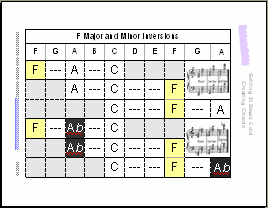 This One Template Will Do More to Get You to Understand Chords than Anyone Else Is Doing
This One Template Will Do More to Get You to Understand Chords than Anyone Else Is Doing
Creating Chords Staff and
Keyboard Visuals
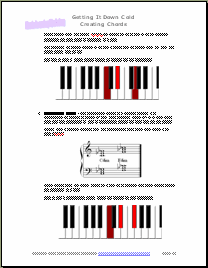
Instruction Comes with Graphic Examples for Every Step
One of Four Creating Chord
Templates for Harmonic Systems
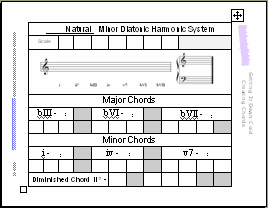
These Templates Are Designed to Let You Create Your Own Theory Book.
I can buy other books that don’t cost as much, why is yours any better?
Look you can actually go to the book store and find a dozen books on music theory. They all have great information in them.
Here’s the thing…
I’ve found that they teach by telling you, not by making you work through it to get it into long term memory.
Actually if you know quite a bit about theory they make a better reference book than a learning book. They let your teachers work on the real teaching part. They just aren’t set up to really teach you in depth.
What about cost?
Let’s take a look at value not cost. The amount of knowledge in this book taught the old traditional way would easily take 3 to 5 years to learn.
And it’s likely you won’t even learn it all by then.
The average cost of lessons is $100 to $125 per month or about $1200 per year. So for easy math let’s say it takes you 5 years to learn all this information.
$1200 x 5yrs = $6000.
Now a lot of that goes to learning your instrument and playing and all that good stuff. But the inadequate theory lessons slow down progress. So you aren’t learning as fast as you should.
My experience is that you are likely to buy 5 to ten books a year while taking lessons.
Say your lucky and only pay on average $10 per book per year, that’s another.
$50 x 5 is equal to $250.
It’s actually more like $500 from the prices out there today. But guess what, they only give you a fraction of the theory you will learn with just this one book.
Now I’ve compared books available and when I tallied up the cost of those books in the store to cover the same amount of learning materials I was shocked.
I was able to easily spend over $100 and it still wasn’t as complete! I even ended up in advanced jazz books to get some of this basic information. How’s the beginning student ever going to make it with that approach?
Take a look at it another way.
If you buy a few course materials that takes 3 to 5 years off your study time, you can save thousands of dollars in lessons and be well on my way to a confident musician whether for fun, profit or dazzling your friends.
Sure it would. You can get there for a whole lot less money and effort.
What do I need to know to be able to use this ?
You can go through the without much additional music theory knowledge.
However, there are a couple of other books we’re going to suggest you consider to ensure that you have a through understanding of the concepts.
You need a basic understanding of intervals. Although this is explained in the workshop a grasp of intervals is going to help you considerably.
Also you need a basic understanding of Scales and Key Signatures.
The Key and Scales workshop is an idea companion to Creating Chords you can work both of these together and get a super boast in learning music theory.
We’ve tried to make this as comprehensive as possible, but it’s hard to learn chords without some knowledge of the other fundamental principals.
Consider adding the other workshops to make your knowledge of music theory as complete as possible.
100% Risk-Free Guarantee
Creating Chords comes with a no-questions-asked, no-hassle, 60 day money back guarantee.
If for any reason whatsoever you decide you aren’t completely satisfied with the books just email me anytime within the next 60 days and I’ll buy it back from you.
 Risk Free
Risk Free
That’s right 60 days to put the these workshops to the test – all risk is on me. How can I get more fair than that.
Start using the workshops and begin seeing immediate results from this system of learning or get your money back, it’s as simple as that.
The longer you wait to get started the longer it will be before you see results.
Don’t put it off and then six months from now think about how much time and money you will have lost.
If you want to make progress you have to begin now.
OK, Are you ready to get ahead of the pack and move my music knowledge down the road fast.
Get it now!
The Creating Chords Workshop
Now $17
Don’t be fooled by the e-book download. This is 100% workshop material designed to be used on your computer.
You only print what you need for a workset and get you through the necessary elements of reading and understanding music beyond the notes.
As a special bonus I’m throwing in the
Learn a Song Report
for free!
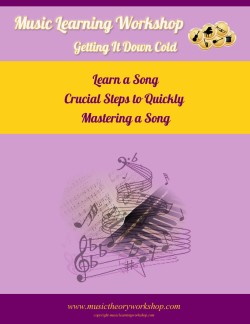
Learn A Song is available with all purchase options, additional bonuses with full course, see below. And all come with Notations and Terminology Book and sample files.
For the Notes Workshop and Bundle options, check them out here:
 Creating Chords at our Store
Creating Chords at our Store
**** Interest in a Full Music Theory Course? ***
Learn More Go Here: Music Theory Course
Every effort has been made to accurately represent this product and its potential. Please remember that each individual’s success depends on his or her background, dedication, desire and motivation. As with any endeavor, there is no certain guarantee that you will learn or achieve the success as fast as predicted.
.. yes get immediate access even at 2:00 A.M.
Here’s to you mastering music,
Click Here To Get Started With Chords Workshop Now
To Your Success!
